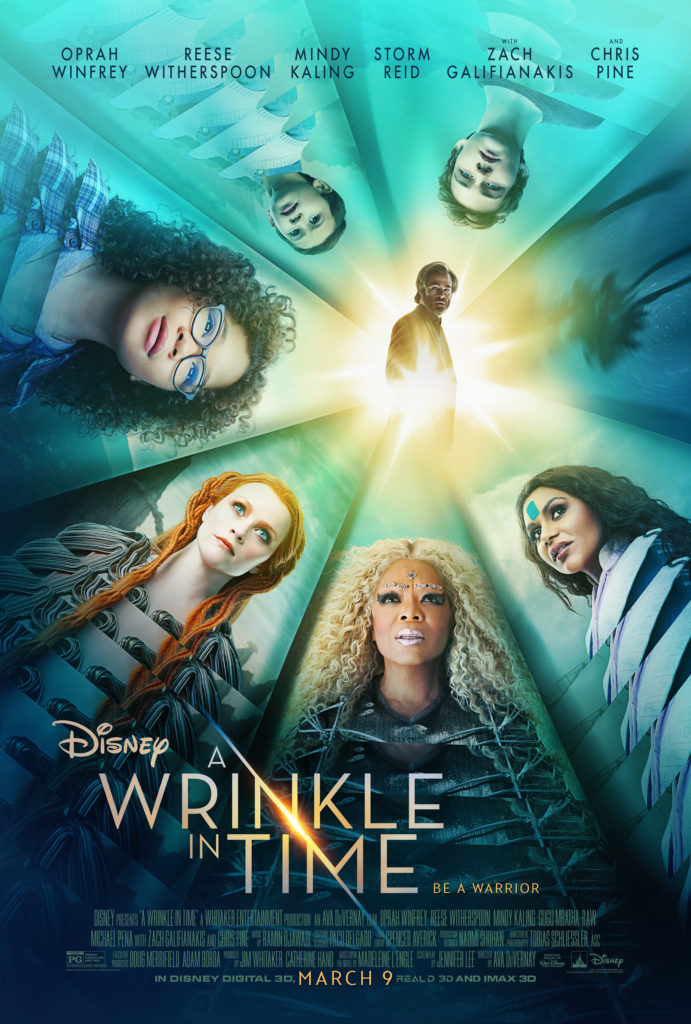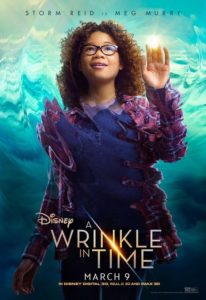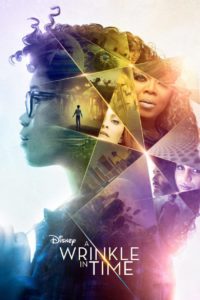Welcome back to Sound Off!, a semi-regular column where members of Speculative Chic gather together to chat about the latest BIG THING in entertainment. This time, be a warrior and discuss A Wrinkle in Time, which premiered in the United States on Friday, March 9, 2018.

Sound Off! is meant to be a reaction, but not necessarily a review. After all, while we are all individuals, even mutual love of something (or hate) can come from different places: you may find everything from critique to fangirling to maybe even hate-watching.
Now, join Merrin, Nancy O’Toole Meservier, and J.L. Gribble as they talk about A Wrinkle in Time. [Note: Spoiler-free!]
 Merrin: I said earlier this year that A Wrinkle in Time was my most anticipated film of 2018, knowing full well that placing my expectations that heavily upon it could mean some crippling disappointment. But friends, I was not disappointed.
Merrin: I said earlier this year that A Wrinkle in Time was my most anticipated film of 2018, knowing full well that placing my expectations that heavily upon it could mean some crippling disappointment. But friends, I was not disappointed.
It’s not a perfect film, and I don’t mean as an adaptation of a beloved book from my childhood. I mean that the special effects weren’t always amazing and some of the quirkiness of the Mrs. Ws gets lost in their costuming. And I will say I’m slightly baffled by the exclusion of the scene from the previews where Meg and her mom explain what a tesseract is to Calvin.
Also baffled by some spoilers that I’m not going to outline for you but will just say that IT, the menacing, malevolent force from the book, loses some of its menace. There’s a scene in the previews of a lot of children standing in their front yards bouncing a ball, and that definitely happens, but that’s the only scene we get of the group think, the hive mind from the book. And it seems strange in a story so bent on diversity (in the best way!) that they wouldn’t point out that the true evil was not only dark and violent but also so concentrated on making everything homogeneous.
In the end, though? I don’t really care that much. I didn’t need this movie to be technically perfect, although I can’t lie and say that wouldn’t have been nice.
What I needed this movie to be was a faithful adaptation of the heart of the book, the thesis that love is the most powerful force in the universe and that accepting yourself, faults and all, can be your greatest strength. And friends, that’s what it was. (Also, just FYI, Mr. Murry explains tesseracts in a flashback during the dinner scene, you just don’t get the solid example of an ant walking down a string.)
Some of its most beautiful moments were quiet moments between Meg and the adults surrounding her, trying to help her believe in herself. The conversation with Mrs. Which about why tessering is so awful for her had me bawling for the younger Merrin, reading herself into Meg Murry. Every interaction with Mrs. Whatsit, speaking Meg’s doubts aloud for Meg to prove wrong. The conversation with the Happy Medium that I wish I could remember word for word about being afraid of the answers to questions. I saw this twice over the weekend, and I cried buckets of tears both times and I’m not in the least ashamed.
I also really love the casting: Storm Reid as Meg and Oprah as Mrs. Which and Chris Pine as Mr. Murry. So good.
 Nancy: Oof. How to review a movie like A Wrinkle in Time.
Nancy: Oof. How to review a movie like A Wrinkle in Time.
There’s a big part of me that wants to explain away all the negative things you may have heard. After all, A Wrinkle in Time is one of those unique projects that exists at the intersection between deeply earnest and undeniably weird. And that’s going to be a hard sell to your typical theatergoer. Is it that much of a surprise that it just doesn’t resonate with a lot of viewers?
Unfortunately, it’s also far from a flawless film.
A Wrinkle in Time is a visual extravaganza, starring a deeply engaged cast. As someone who loved the book both as a child and a college student, I was pulled into the story from the start. I truly felt for Meg, and her desire to find her father and reunite her family. And there are some scenes that made me feel just like I did when reading them for the first time.
At the same time, I found myself deeply suspicious that, had I not previously fallen in love with the characters, I would be a lot more critical. There are emotional payoffs that don’t have the necessary build-up to truly resonate with viewers not previously invested in the story. The dialogue often feels weirdly old-fashioned when placed in contrast to the otherwise inoffensive modern pop songs that populate the soundtrack, and the score is relentless to the point where it actively got on my nerves. I found many of the creative decisions worth applauding — including the film’s multiracial cast and decision to make Charles Wallace Meg’s adoptive brother instead of related by blood — but there are other ones then I’m less sure of. Why change IT’s true form, for example? And was it a good idea to strip a very religious book of all of its religious implications?
A big part of me still feels that people are being overly critical of A Wrinkle in Time. After all, I didn’t think it was necessarily a bad movie as much as it was a deeply uneven one. If you’ve read the book and are curious about the results, it’s not a bad idea to give it a chance. Just go in with modest expectations. And make it a matinee.
 J.L.: I’m not sure whether it’s beneficial or detrimental that I did not have a close relationship with the novel A Wrinkle in Time while growing up like so many others. In fact, I only read the book for the first time a few weeks ago. Since I wasn’t especially married to the original subject matter, I may have appreciated the modernization of the time period more than some others.
J.L.: I’m not sure whether it’s beneficial or detrimental that I did not have a close relationship with the novel A Wrinkle in Time while growing up like so many others. In fact, I only read the book for the first time a few weeks ago. Since I wasn’t especially married to the original subject matter, I may have appreciated the modernization of the time period more than some others.
The kids who played Meg, Calvin, and Charles Wallace absolutely stole the show, which is the one thing I probably did particularly care about. Storm Reid translated Meg’s stubbornness into genuine stress and fear, whereas Cal’s crush on Meg was adorable rather than sappy. And whichever casting director found Deric McCabe to play Charles Wallace deserves an Academy Award. (Do they have Oscars for casting? I don’t care. Make one.) I understand why the twin brothers were cut from the film, and I appreciated that Charles Wallace is an adopted child, which actually makes his reaction to Dr. Murray at the end more reasonable.
Much of the marketing for this movie has focused on the fantastical natures of Mrs. Whatsit, Who, and Which, portrayed by Reese Witherspoon, Mindy Kaling, and Oprah Winfrey, respectfully. Out of the three of them, unfortunately, it seemed that only Mrs. Whatsit actually had a character. Mrs. Who was too limited by her need to speak in quotations (though I loved how many of them were updated), and Mrs. Which was pretty blatantly just a really chill Oprah on the big screen.
The visual elements of this film were incredible. I feel like I say that about a lot of the films that I review here, which basically just means that technology has really started to catch up to how some films need to be presented. Without diving too far into spoiler territory, not every planet that the characters visit is presented in this film. While I understand the story arc reasons behind cutting one particular planet, I still would have been curious to see how Ava DuVernay might have presented it visually.
In the end, my only major complaint was that the film’s score occasionally included lyrics, which felt jarring and distracting to the action on screen. Other than that, this was a fun kid’s movie that adults can still appreciate. I hope it brings more people to the genre of speculative fiction while they are young.
To learn more about J.L.’s thoughts on A Wrinkle in Time, tune in to the next episode of the Ink to Film podcast!

My theater-going capability has been suffocated, so I probably won’t see this until it’s rentable and/or on Netflix. I’ll keep expectations low, and I don’t plan on reading the book before seeing it, so it’ll be interesting!
[…] via Sound Off! A Wrinkle in Time — Speculative Chic […]
It’s a bummer it didn’t do so well critically. I thought the previews looked really good, and I also think the novel deserves a quality adaptation.